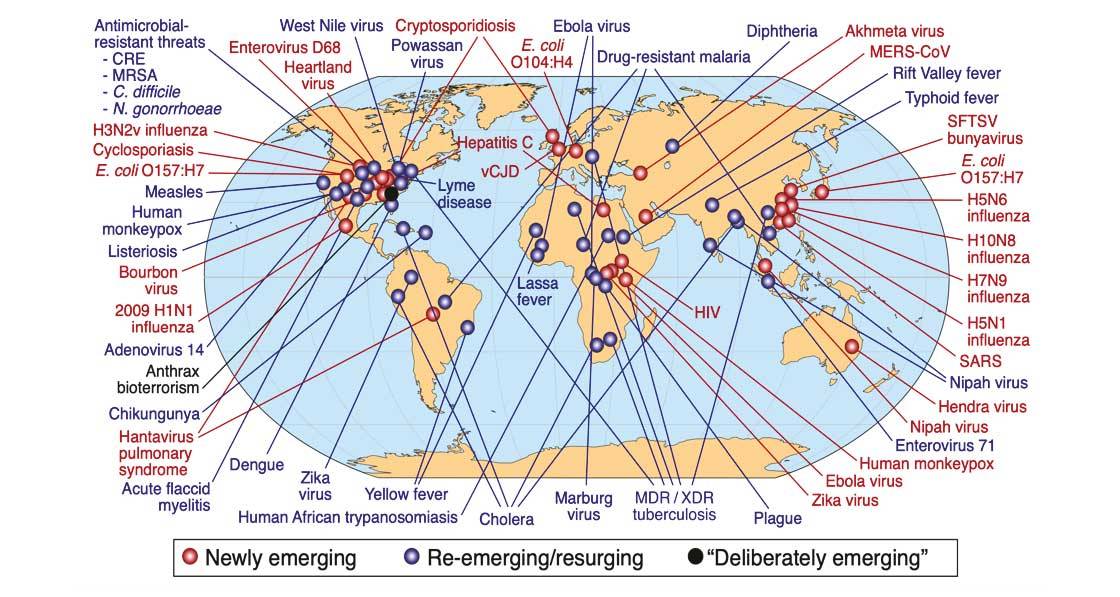
- Blogs
- Posted
Are we the virus?
Taking a temporary detour from his series of columns on the history of sustainable building and renewable energy, Dr Marc Ó Riain takes a look at Covid-19 from the perspective of Gaia theory, and at the relationship between collapsing ecosystems and the emergence of new infectious diseases.
This article was originally published in issue 34 of Passive House Plus magazine. Want immediate access to all back issues and exclusive extra content? Click here to subscribe for as little as €10, or click here to receive the next issue free of charge
Diverting from my usual column I have taken the opportunity of solitude to review some academic papers and books relating to the development of Covid-19 in an environmental context.
James Lovelock’s Gaia theory (1972 & 2009) proposes that the planet is a complex interacting system much like a single organism. In this vision, humans are the virus making the organism unstable, and thus Gaia’s immune system will find ways of fighting the virus... in our case with a virus, and it is not the first example.
The Spanish flu, Covid’s most appropriate antecedent, lasted three years, and was caused by the conflagration of war, mixing of French soil, multinational armies, poor quality living conditions, stress, fear and the use of chemical gases, with its virulence aggravated by the repatriation of soldiers, creating a true global pandemic (Erkoreka, A. 2009, ‘Origins of the Spanish Influenza pandemic (1918–1920) and its relation to the First World War’, Journal of Molecular and Genetic Medicine).
Although in a different context, our increasing travel, trade, industry, population, pollution and expansionist agriculture has placed an ever-increasing pressure on the fringes of regional biodiversity. This is scientifically linked to a “a rise in disease emergence and the potential for pandemics” according to researchers (Jones et al 2013, ‘Zoonosis emergence linked to agricultural intensification and environmental change’, Proceedings of the National Academy of Sciences USA).
The rate of detection of these novel and epidemic-prone diseases, like Covid-19, is increasing in frequency, and they are increasingly difficult to manage; H1N1, SARS, MERS, Ebola, Zika, Yellow Fever... Between 2011 and 2018, WHO tracked 1,483 epidemic events in 172 countries.
We disrupt ecosystems, and we shake viruses loose.
The increase in novel diseases is emerging from the fringes of our societies along the edges of biodiversity “hotspots” such as tropical rainforests and bushmeat markets in Brazil, Africa and Asia, but driven by the northern hemisphere’s demand for meat, minerals and materials.
According to the Centre for Disease Control in the US, approximately 75% of emerging infectious diseases and 60% of all pathogens that infect humans have originated in animals.
David Quammen (2012) prophetically warned us: “we cut the trees; we kill the animals or cage them and send them to markets. We disrupt ecosystems, and we shake viruses loose. A parasitic microbe, thus jostled, evicted, deprived of its habitual host, has two options— to find a new host or a new kind of host... and often, we are it.”
In 1997, epidemiologist Donald S Burke at the University of Pittsburgh identified that the coronavirus (CoV) has a proven ability to cause epidemics in animal populations and intrinsic evolvability to recombine to cause pandemics in the human populations. Burke argued that world governments and NGOs needed to be actively monitoring remote places to identify local spill-overs of CoV, with field capabilities to suppress the disease before it becomes a regional outbreak.
An interesting example of such monitoring is the research carried out by the Global Viral Forecasting Initiative (GVFI), which blot tested bush meat in high risk areas for emerging viruses, in a systematic effort to stop the next pandemic before it begins to spread (Quammen, David, 2012, ‘Spillover: Animal Infections and the Next Human Pandemic’, WW Norton & Company). This is exactly the type of research that needs to be funded and broadened to arrest pathogens in small clusters, thus eliminating the virus in human populations before they get a more widespread foothold.
The development of these novel viruses is part of a larger pattern, one which we are responsible for, one where Gaia is defending herself against us. Perhaps we need to flatten the curve of population growth, sooner rather than later, as the force of population expansion is pressuring environments, creating the opportunity for viruses to jump species.
Although world population is projected to stop growing by the end of the century, per capita energy consumption and CO2 emissions have steadily increased over the past 50 years, thus the pressure on habitat may still exist.
We need to start protecting our naturally biodiverse regions, retaining them as the lungs of the planet but also to contain the potential pathogens that may bring us to our knees again.
The northern hemisphere also needs to take responsibility in returning biodiversity to parts of our farmlands, and by financially supporting the protection of tropical ecosystems.
We reap what we sow, in terms of the terrible consequences of lives lost and economies shut down. We need to wake up and start to anticipate the next environmental shock, change our behaviours and our laws before the planet works out how to live without us






